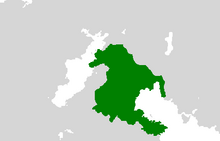User:Devink/sandbox3: Difference between revisions
No edit summary |
No edit summary |
||
| Line 62: | Line 62: | ||
|symbol = <!-- Link target under symbol image. Default: Coat of arms of {{{common_name}}} --> | |symbol = <!-- Link target under symbol image. Default: Coat of arms of {{{common_name}}} --> | ||
|symbol_type = <!-- Displayed text for link under symbol. Default "Coat of arms" --> | |symbol_type = <!-- Displayed text for link under symbol. Default "Coat of arms" --> | ||
|image_map = | |image_map = Drevstran NeoBayarids.png | ||
|image_map_alt = | |image_map_alt = | ||
|map_width = 220px | |map_width = 220px | ||
|image_map_caption = | |image_map_caption = | ||
|image_map2 = <!-- If second map is needed - does not appear by default --> | |image_map2 = <!-- If second map is needed - does not appear by default --> | ||
|image_map2_alt = | |image_map2_alt = | ||
| Line 141: | Line 141: | ||
===Convertion to Christianity=== | ===Convertion to Christianity=== | ||
Kando II's decision of submitting to pagan rulers was contested and criticized in both of his realms, leading to protests and insurections. | Kando II's decision of submitting to pagan rulers was contested and criticized in both of his realms, leading to protests and insurections. To stabilize their rule in the newly conquered regions, Tugan Khan, greatson of Olig Kuz, decided to convert to {{wp|Orthodox Christianism|Christianity}}. It was the beginning of a long lasting alliance between the {{wp|Orthodox Christianism|Idoloclast Orthodox Church}} and the Tümen. | ||
===Wars against the Lushyodorstag=== | |||
Revision as of 12:36, 31 May 2020
Great State of the Tümen Ikh Tümen Uls | |||||||||
|---|---|---|---|---|---|---|---|---|---|
| 1145–1700 | |||||||||
 | |||||||||
| Status | Kingdom | ||||||||
| Religion | Sünsnüüd Orthodox Christianity | ||||||||
| Khan | |||||||||
• Military Assembly | Assembled Thousand | ||||||||
| History | |||||||||
• Migration of the Tümen eastward | 1145 | ||||||||
• Disestablished | 1700 | ||||||||
| |||||||||
The Great State of the Tümen, more commonly known by their nickname of Neo-Bayarids was originally a Bayarid Khanate originating in the northwestern sector of the Empire before becoming a functionally separate khanate. It was founded by Olig Kuz, a Bayarid Myriarch serving as the commander of the fortification of the North-Western border. During the collapse of the Empire Olig Kuz, with the help of local vassals or bordering states, established his own Khanate which became known as the "State of the Ten Thousand Warriors". Olig Kuz would continue to solidify his rule, defeating both other Bayarid rivals and oportunistic neighbors. The power of the Tümen peaked during the 13th century, when its territories included a vast stretch of lands from Lake Kulpanitsa in the west to Boika in the east and dominated most of modern Drevstran.
History
Bayarid Origin
Participation in the Ikonkivoyra
The Grand Ikonkivoyra lasted for 230 years, between 1020 and 1260, and saw the Sevromark becoming one of the major powers in Eastern Belisaria, pushing back the Lushyods and conquering most of the Duchy of Yugstran. Desesperate, Duke Kando II reached out to the Tümen Khan for help against its Iconoclast rival. After quick negociations, the Khan agreed to join the war in exchange of Kando's alliegeance. The combined Tümen-Yugstraneses forces quickly and repeatedly defeated the Sevromark in battle, killing King Kzvar III in battle in 1256 and capturing his son and successor three years later. The kingdom ended when the nine years old Abran was forced to renounce his title and convert to Orthodoxy. He died four years later without heir as a captive of the Seredinian court.
Following Abran's abdication, the Sevromark was reorganized into the Duchy of Drevstran, offered to Kando II while his duchy of Yugstran was elevated to the status of a principality.
Convertion to Christianity
Kando II's decision of submitting to pagan rulers was contested and criticized in both of his realms, leading to protests and insurections. To stabilize their rule in the newly conquered regions, Tugan Khan, greatson of Olig Kuz, decided to convert to Christianity. It was the beginning of a long lasting alliance between the Idoloclast Orthodox Church and the Tümen.